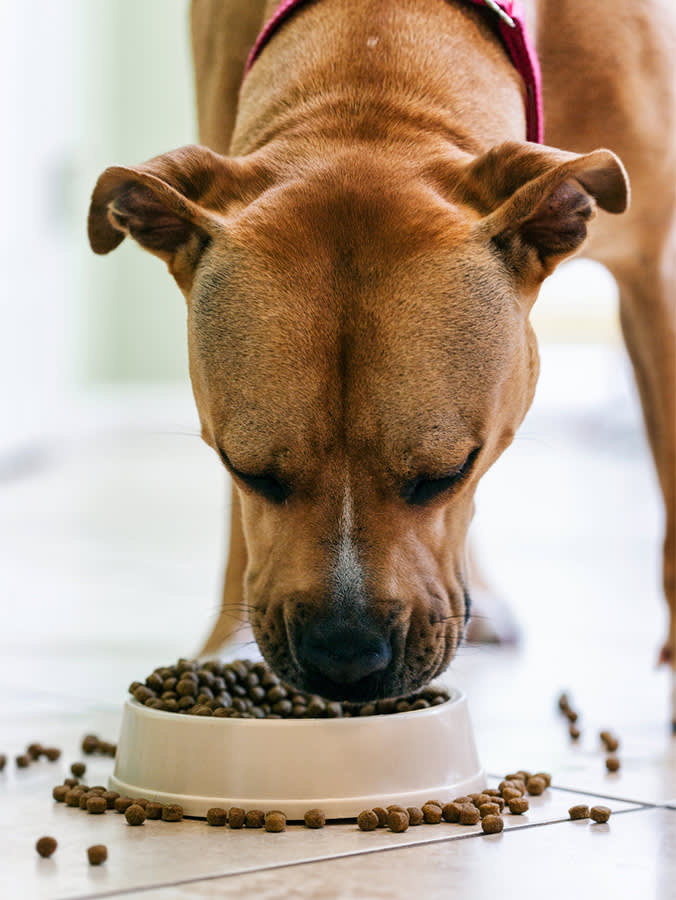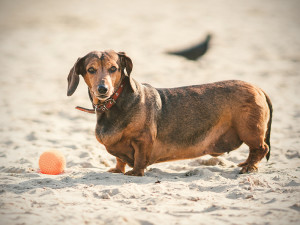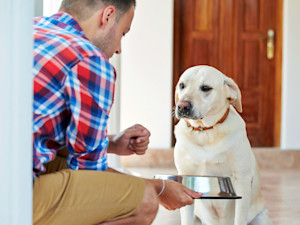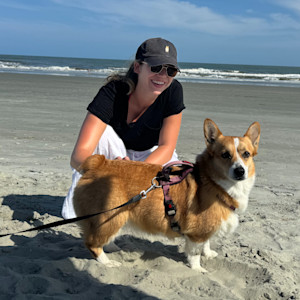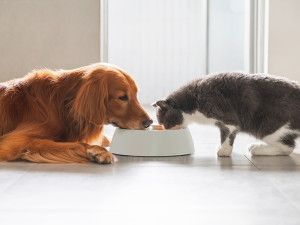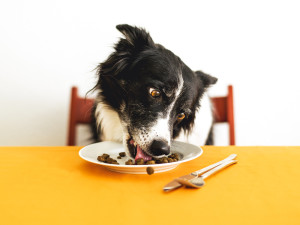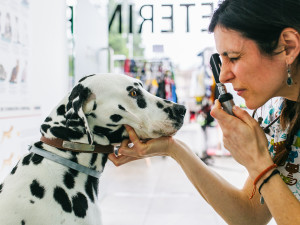Dog Obesity Is Highest in These 10 States—But It’s More Complicated Than That
Per this study, American dogs are overweight—but you have to consider these factors.
When up against those sweet puppy-dog eyesopens in new tab, many pup parents have been guilty of feeding their pet more food, treats, or table scraps than they maybe should. A 2021 studyopens in new tab (updated in May of this year) from One Vet suggests that some states in the United States may deal with this issue more than others.
There’s nothing wrong with a dog who loves food — and nothing wrong with spoiling your pup, either. But over time, those extra treats can lead to some extra pounds. The study showcases results from a survey of 2,430 pet parents across 42 states. Researchers compared respondents’ answers about their dogs’ weight, sex, and breed against standards set by American Kennel Clubopens in new tab to determine whether the dog was overweight and by how many pounds.
Trick question: All dogs are perfect! But find out which type is the best fit for you.
The following are the top 10 states, ranked by the average number of pounds the dogs were overweight:
Pennsylvania: 18.25 pounds overweight
Virginia: 16.67 pounds overweight
Wisconsin: 16.38 pounds overweight
Georgia: 16.18 pounds overweight
West Virginia: 15.66 pounds overweight
Connecticut: 15.54 pounds overweight
New Hampshire: 14.23 pounds overweight
New York: 14.03 pounds overweight
Nebraska: 13.73 pounds overweight
Tennessee: 13.33 pounds overweight
While the findings indicate that some states have more overweight dogs than others, canine obesity is a complex topic that has a lot more going on than just a number on the scale. The study, led by Lily Valez, head of special reports at One Vet, is based on a survey originally conducted in August of 2021. While it did not include questions about activity level or feeding patterns, Valez’s team was able to draw conclusions based on the state and breed data collected.
How much do you spend on your pet per year?
Most reported overweight breeds were small breeds, including Pomeranians, Yorkshire Terriers, Bulldogs, and Chihuahuas. “Toy breeds may be more likely to be treated as ‘indoor dogs,’ especially given that they’re a popular choice for apartment dwellers,” Valez tells us. “As such, these dogs are more likely to have sedentary lifestyles when compared to larger, more active breeds.”
Valez says apartment living could also be a reason so many overweight dogs are concentrated along the northern part of the East Coast: “Many of these states have large metropolitan areas, where significant segments of the population are living in apartments,” Valez says. “Many of these dogs end up living sedentary lifestyles because of a lack of outdoor space or dedicated times for exercise, leading them to become overweight.” (Remember, there are always ways to get your dog the enrichment and exercise they need, even if you’re living in tight quarters and in a city).
Pennsylvania-based veterinarian Dr. Bryan Langlois, medical director at Spay-Neuter Save Networkopens in new tab, notes that certain states may be ranked high in the study because of what breeds are popular in those states.
“Pennsylvania has a high population of commercial breeders, and usually, they’re breeding all types of breeds, but especially some of those smaller breeds dogs that are more in demand, which sometimes can lead to them being more obese compared to the hunting, working dogs that you see maybe more down South,” Langlois says. These days, many of these “in-demand” purebred dogs are showing up at shelters, too.
The details matter.
Despite these patterns, Langlois suggests that one of the study’s biggest problems is that it uses weight exclusively to determine obesity. This is a major limitation because it does not take body-fat content, muscle mass, and other factors into consideration. It’s the same reason why slapping a (often harmfuopens in new tab l) label on a human being based on what the scale says isn’t accurate, either.
“It’s not just how many pounds the animal weighs, it’s how they’re carrying that weight,” Langlois says. “It’s sort of the same in people, where you could have two people that are both, say, five feet, six inches tall, both weighing 230 pounds, one could ... have a high-body-fat percentage and one could be really muscular and have a low-body-fat percentage.”
Because of these variations, most veterinarians use a practice called body condition scoring (BSC)opens in new tab to determine whether a dog is a healthy weight. BCS involves using touch and sight to determine if a dog is a healthy weight. The BCS scale ranges from one to nine and assesses your pet based on the following: “thin,” “normal,” “overweight,” and “obese.” Veterinarians can perform a formal BCS determination, but pet parents can also do an at-home test by feeling and looking at their dog. In dogs with “healthy” scores, you can easily feel the ribs, spine, and hip bones; there is a visible waist; and the abdomen has a slight tuck or upward slope visible from the side.
“Every dog is a little different, even the same breed,” Washington-based veterinarian Dr. Jamie Freyer says. Maybe one’s taller, maybe one’s stockier. They all have their different information, so that’s the most reliable way to tell if a dog’s weight is a good weight for them or not.”
Because canine obesity is on the rise, the visual cues that point to a healthy weight may be jarring to some people. “A lot of time, people with dogs that are actually in really good condition, they get shamed because people think that they’re underweight, because they are so used to seeing pets that are actually overweight,” Freyer says.
In 2022, veterinarians found that 56 percent of dogs were either overweight or obese, according to the Association for Pet Obesity Prevention (APOP)’s 2022 State of U.S. Pet Obesity Reportopens in new tab, which features data of 880 dogs. Despite the prevalence of canine obesity, the survey highlights a lack of awareness; 36 percent of parents of overweight and obese dogs said they considered their dog’s body condition to be “normal.”
If there are risks to your dog’s health, your vet may suggest these changes.
Again, we love our pups no matter what size they are. But obesity in dogs can lead to many serious health issues, including diabetes, orthopedic issues, and decreased life expectancy, according to the APOP. With the many potential health implications, it’s important that pet parents recognize when their dog is overweight and take steps to address it.
Usually, it is easier to prevent a dog from becoming obese than it is to treat a dog who is already obese. You’ve probably heard this one at your vet’s office before, but maintaining a healthy weight requires a combination of exercise and diet. Dogs should have at least 20 to 30 minutes of aerobic activity, such as walking, playing, or swimming, per day, according to the APOP. Depending on age, breed, and activity level, they may require more.
Regarding diet, it is usually best to consult a veterinarian about types of food and portions. Parents should also regularly reassess food type and portions at different stages of a dog’s life. For example, a senior dog has different diet needs than a puppy, and a dog recovering from surgery has different needs than an active, healthy dog.
This also leads us to discuss your dog’s favorite word: treats. Our dogs love t-r-e-a-t time, and we love it, too, because it makes them happy. But keep in mind that high-reward treats, like peanut butter, can be high in calories (and those calories can add up).
“With portion size, I think a lot of people don’t really understand the intricacies of the way feeding treats is different for different pets,” Freyer says. “If you have a Great Dane, and you feed them a couple baby carrots and a dog bone or something during the day, that’s not a big deal. If you have a Chihuahua and you feed them the same stuff, that’s a huge number of calories for their size.”
Freyer recommends that treats account for no more than 10 percent of a dog’s daily caloric intake. She also suggests low-calorie options, like dog-safe fruits and vegetablesopens in new tab, such as carrots and celery.
Heads up: Those small changes can feel big to your pup.
Helping a dog lose weight is a process that your vet should help oversee, especially because there are factors outside of food and lifestyle, such as thyroid disease or genetic conditions, that could impact weight.
That being said, for healthy dogs without preexisting conditions, the dog will need to eat fewer calories and burn more calories to lose weight. Veterinarians can provide guidance about types of food and appropriate portions for weight loss. Cutting back on food and treat intake can be a challenging process
As creatures of habit, dogs may respond poorly to changes in their eating routine, which can lead to bad behavior, such as begging. Certain diet and prescription dog foods may alleviate this problem by helping dogs feel more full with fewer calories. Pet parents should consult their veterinarian before making drastic changes to their dog’s diet.
Exercise may need to be introduced slowly for dogs who are obese and may not be used to regular walks, especially those dogs whose weight has caused joint pain or other orthopedic issues. Starting slow, talking breaks, and gradually working up to longer walks can help an obese dog ease into a fitness routine.
But remember: You’re in this together.
Freyer cautions that helping a dog achieve and maintain a healthy weight is an ongoing journey that requires regular evaluation.
“You’re the one that’s with your dog all the time, so you really have to monitor that body condition score and look at them,” Freyer says. “Think, ‘Well maybe you’ve lost a little more weight than I want you to. I’m going to up your food.’ or ‘You feel a little bigger than a month ago so I’m going to take your food down a little bit.’ Sometimes it’s a little bit of trial and error.”
While it can be a challenging journey, helping dogs reach and maintain a healthy weight can improve and elongate their quality of life. And we can all agree: That’s the goal.
